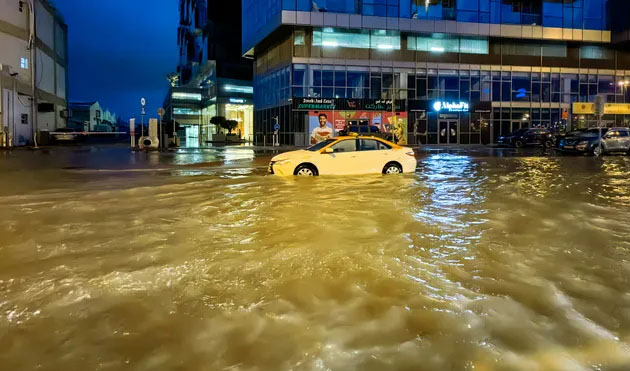
Photo Credit: AP
Recent storms lashed the United Arab Emirates and Oman, dumping 25 centimeters (approximately 9.84 inches) of rain. In Oman, the deluge claimed at least 20 lives, while one fatality was reported in the UAE. The storm initially struck Oman on Sunday before
unleashing its force on the UAE by Tuesday, triggering power outages and flooding runways, causing significant flight disruptions.
Rainfall is a rarity in the UAE and across the Arabian Peninsula, known primarily for its arid desert climate. However, the recent flooding in Dubai raises questions about the factors contributing to this unusual phenomenon. One potential factor could be cloud seeding, a form of weather modification frequently conducted in the UAE.
Cloud seeding aims to alter precipitation patterns by introducing substances such as silver iodide into clouds to enhance rainfall. While cloud seeding is intended to address water scarcity, its effectiveness is influenced by various factors beyond human control, including cloud dynamics, existing weather patterns, and atmospheric stability.
Consequently, there is a level of uncertainty surrounding the outcomes of cloud seeding operations, including the possibility of unintended consequences such as flooding. Another possible cause of the storm is climate change. A change in weather patterns can alter atmospheric circulation patterns leading to shifts in weather systems such as the jet stream and monsoon patterns.
These changes can influence the distribution and intensity of rainfall events, causing some regions to experience more frequent and intense rainfall, while others may face prolonged periods of drought. In regions where heavy rainfall events become more common, the risk of floods increases.
The larger storm system could have also caused the unpredicted rains as it transverses through the Arabian Peninsula and moves across Gulf of Oman which brings about wet weather. The storm systems often feature strong vertical motion, which can lift warm,
moist air from near the surface into the atmosphere.
As the air rises, it cools andcondenses forming clouds and precipitation. The lifting mechanism, known as atmospheric instability, particularly pronounced in thunderstorms and tropical cyclones, where connective processes play a significant role in precipitation formation.
Others include heavy rainfall which causes floods and poor drainage systems to cope with heavy rains since it is a dessert country. Future rainfall extremes are also expected due to increased global warming.
Email: This email address is being protected from spambots. You need JavaScript enabled to view it.






















